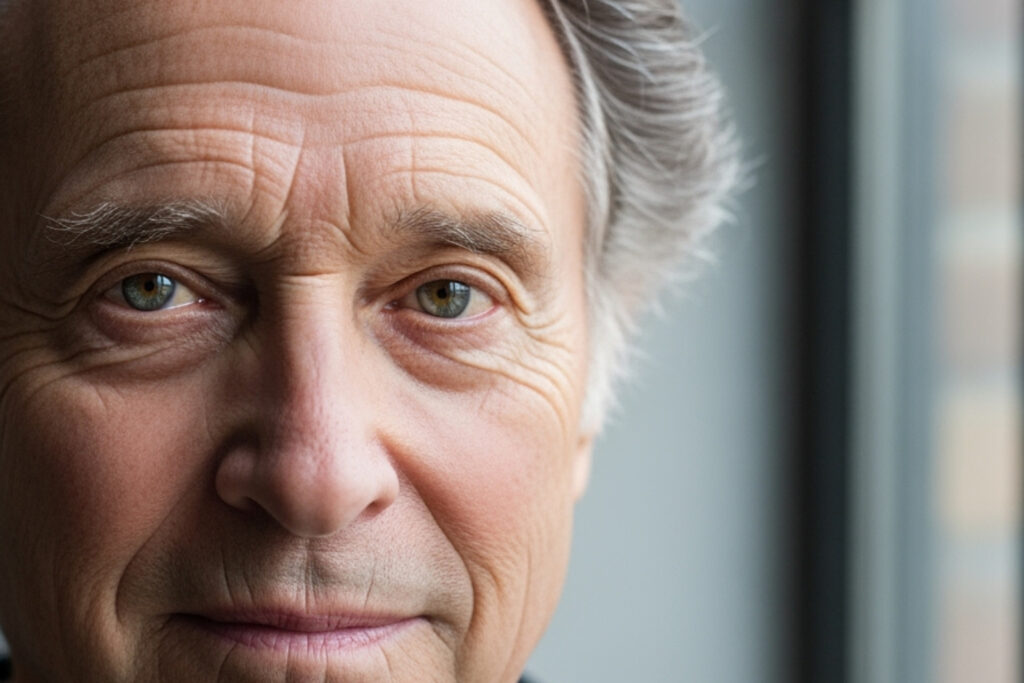Who is Richard Dreyfuss: Hollywood Legend and Controversial Figure
Richard Dreyfuss is an Academy Award-winning American actor who became a major Hollywood star during the 1970s New Hollywood movement. Born on October 29, 1947, he’s 77 years old and remains active in entertainment and political commentary.
Quick Facts About Richard Dreyfuss:
- Age: 77 years old (born October 29, 1947)
- Famous For: Jaws (1975), Close Encounters of the Third Kind (1977), The Goodbye Girl (1977)
- Awards: Academy Award winner for Best Actor, Golden Globe, BAFTA
- Record: Was the youngest man to win Best Actor Oscar at age 30
- Recent News: Made controversial comments at a 2024 Jaws screening event
- Activism: Founded The Dreyfuss Civics Initiative to promote civics education
Dreyfuss emerged as a major star through collaborations with director Steven Spielberg and became known for playing fast-talking, wisecracking characters. His films from 1973 to 1978 collectively grossed over $900 million worldwide.
Beyond his acclaimed acting career, Dreyfuss has faced personal struggles like cocaine addiction and bipolar disorder, which he’s openly discussed. He’s also become increasingly vocal on political and social issues, leading to recent controversies that have overshadowed his artistic achievements.
He once reflected: “I really think that living is the process of going from complete certainty to complete ignorance.” This quote captures his philosophical nature and the complex journey of his decades-long career.
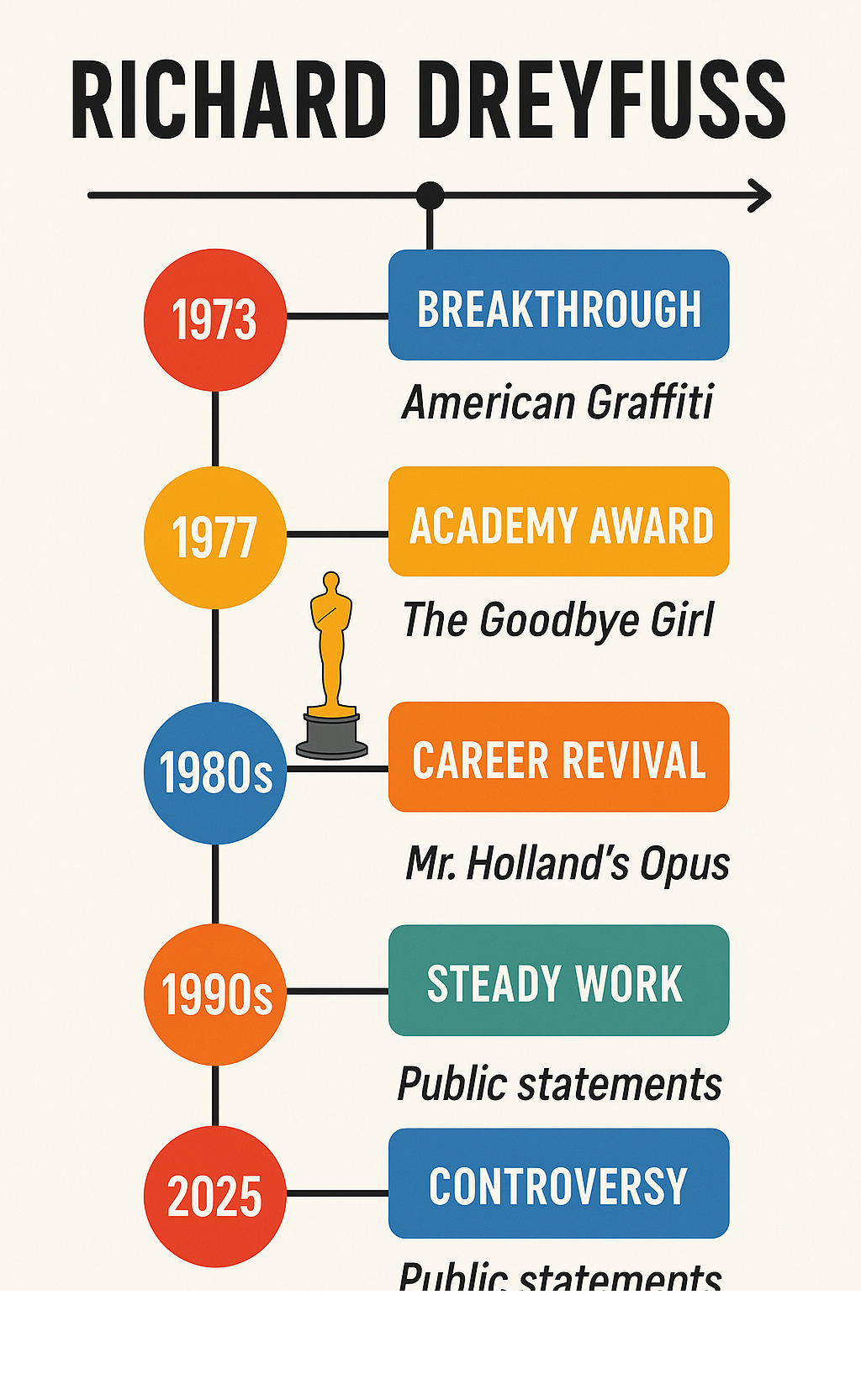
Richard dreyfuss terms you need:
From Summer Blockbusters to Oscar Gold: A Legendary Career
Looking back at the incredible journey of Richard Dreyfuss, we see a career that didn’t just climb; it soared. He went from smaller parts to owning some of the most iconic roles in movie history. His special mix of intense energy, sharp mind, and relatable “everyman” charm made him a true star during the exciting New Hollywood era. He grew from a “nervy Jewish kid” into a seasoned actor who brings immense depth and a wonderfully “no-nonsense, no frills honesty” to every role.
His early days saw him making a big impact, from an uncredited line in The Graduate (1967) to his breakout as Baby Face Nelson in Dillinger (1973). This set the stage for an amazing run of films that defined the 1970s. Movies like George Lucas’s American Graffiti (1973) and The Apprenticeship of Duddy Kravitz (1974) showed his talent for playing “irritating pests and brash, ambitious hustlers,” earning him praise for his “almost manic energy.”
But it was working with director Steven Spielberg that truly cemented his place as a leading man. First, as the smart, slightly eccentric oceanographer Matt Hooper in the game-changing summer blockbuster Jaws (1975). And then, as the determined Roy Neary in Close Encounters of the Third Kind (1977). These roles, in particular, helped create the “summer blockbuster” as we know it today. It’s clear that Richard Dreyfuss perfectly embodied the “little guy, who lives out the fantasies of the everyman for trip, love, and heroic action.”
The absolute peak of this early success arrived with his Oscar-winning performance as Elliot Garfield in The Goodbye Girl (1977). This role wasn’t just funny; it showed his incredible ability to be vulnerable and charming all at once. At just 30 years and 125 days old, Richard Dreyfuss became the youngest actor to win the Academy Award for Best Actor, a record he held for 25 years! This amazing achievement, along with his wins at the Golden Globe and BAFTA Awards for the same film, firmly placed him among Hollywood’s elite. And here’s a fun fact: standing at approximately 5 feet 4¼ inches, he was, for a time, the shortest actor ever to win that Best Actor Oscar.
Even after facing some personal struggles in the early 1980s, Richard Dreyfuss made a powerful comeback, proving he was still a formidable presence on screen. Movies like Down and Out in Beverly Hills (1986), Stand by Me (1986), where he provided the heartwarming narration, and the hilarious What About Bob? (1991) showcased his continued versatility and comedic genius. His reported salary for What About Bob? was a significant $5,000,000, a clear sign of his star power. Later, his moving portrayal of music teacher Glenn Holland in Mr. Holland’s Opus (1995) earned him another Academy Award nomination, reminding us all of his enduring talent and the powerful emotions he could convey.
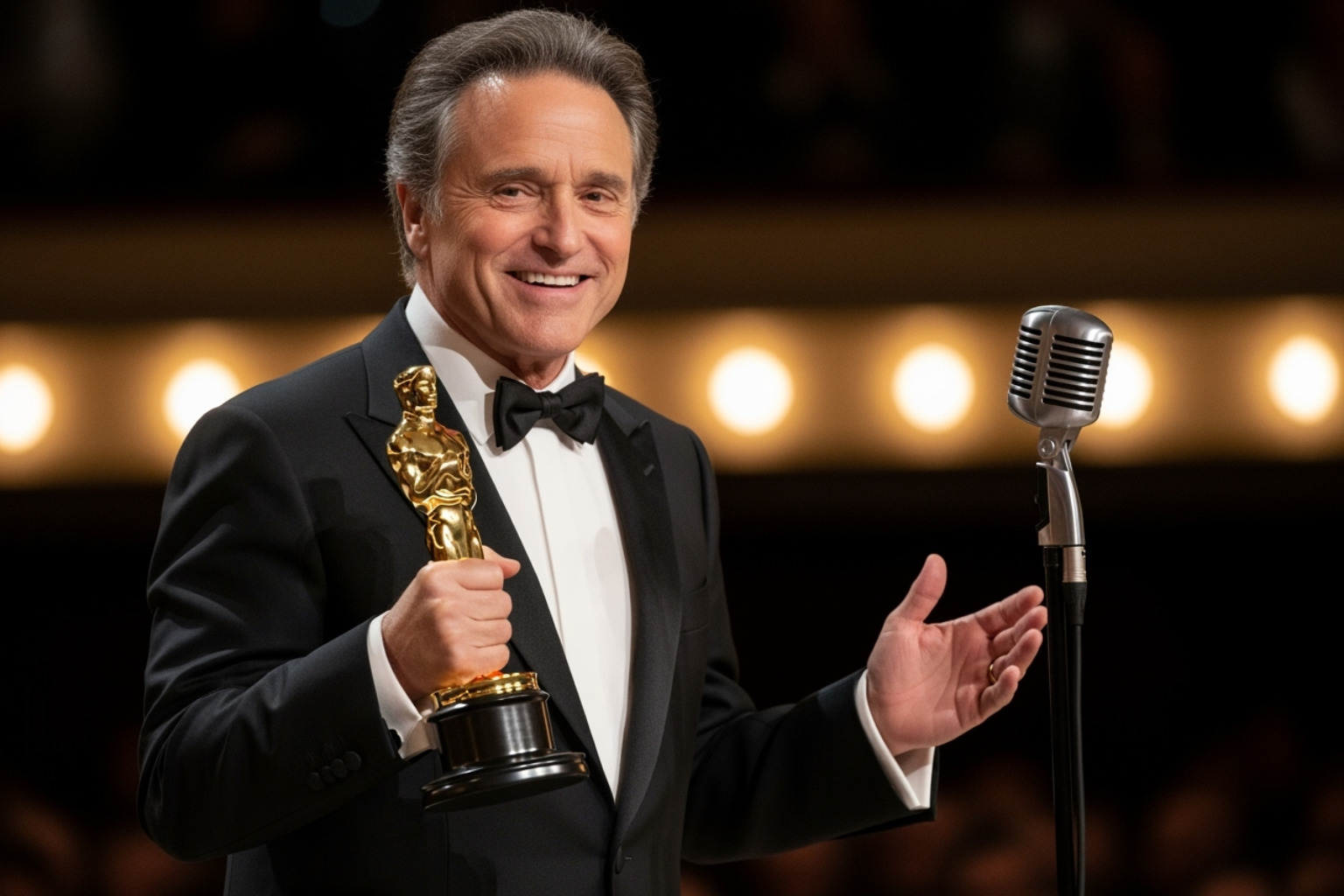
An Unforgettable Filmography
When we think about Richard Dreyfuss’s filmography, certain roles immediately pop into our minds because of their impact and his truly memorable performances. We’ve touched on a few already, but let’s highlight some of these iconic portrayals that have left a lasting mark on cinema:
- Matt Hooper in Jaws (1975): He brought to life the smart, slightly quirky oceanographer who reluctantly teams up with the local police chief and a grizzled shark hunter. This role not only made him a household name but also helped redefine the action hero – intelligent and relatable, rather than just muscular.
- Roy Neary in Close Encounters of the Third Kind (1977): Here, he played a blue-collar electrician whose life is turned upside down after a UFO encounter, sending him on an obsessive quest. His performance perfectly captured the wonder and determination of an ordinary man pulled into an extraordinary event.
- Elliot Garfield in The Goodbye Girl (1977): The struggling actor who unexpectedly finds himself sharing an apartment with a single mom and her precocious daughter. His Oscar-winning turn brilliantly blended humor with genuine human emotion, creating a character who was both frustrating and incredibly endearing.
- Glenn Holland in Mr. Holland’s Opus (1995): A composer who reluctantly takes a music teaching job to support his family, only to find his true calling in inspiring generations of students. This role deeply resonated with audiences, beautifully portraying the quiet dedication and profound impact of a passionate educator.
Throughout his career, Richard Dreyfuss has worked alongside an impressive lineup of co-stars, including Bette Midler, Nick Nolte, Barbra Streisand, and Bill Murray. This really shows his ability to create compelling chemistry on screen with anyone! His IMDb profile boasts an astounding 130 acting credits, 15 producer credits, and 4 writer credits, proving his extensive involvement across many aspects of filmmaking. We are truly proud to feature him as a genuine Hollywood veteran. For those curious about the careers of other celebrated actors, like the versatile Bill Skarsgard, check out his movies and TV shows and explore other filmographies and roles within our extensive resources.
Major Awards and Achievements
Richard Dreyfuss’s immense talent has been recognized by the most prestigious organizations in the entertainment industry. He holds an impressive collection of accolades that truly highlight his significant contributions to film and television. We can see his impact through the following:
| Award Category | Wins | Nominations |
|---|---|---|
| Academy Award | 1 | 2 |
| Golden Globe | 1 | 2 |
| BAFTA | 1 | 1 |
His Oscar win for The Goodbye Girl is certainly the shining moment, but his nomination for Mr. Holland’s Opus also speaks volumes about his sustained excellence. Beyond these major awards, Richard Dreyfuss has gathered a total of 20 wins and 20 nominations throughout his career! This includes a Satellite Award for The Day Reagan Was Shot (2001) and a Saturn Award for Weeds (2011), showing his wide range.
In recognition of his lasting legacy, Richard Dreyfuss received a well-deserved star on the Hollywood Walk of Fame on October 10, 1996. You can find it at 7021 Hollywood Blvd! This permanent mark in Hollywood history is a wonderful testament to his enduring popularity and impact. What’s more, the commercial success of his early work is simply undeniable: between 1973 and 1978, the films Richard Dreyfuss appeared in collectively grossed over $900 million. That’s a remarkable feat that truly highlights his box-office appeal during a pivotal period in cinema.
The Man Behind the Roles: Personal Triumphs and Challenges
Behind the iconic performances and Hollywood success, Richard Dreyfuss has steerd a personal journey of profound struggles and remarkable resilience. His story reminds us that wellness goes beyond surface appearances—it’s about confronting our demons, embracing vulnerabilities, and finding the courage to rebuild.
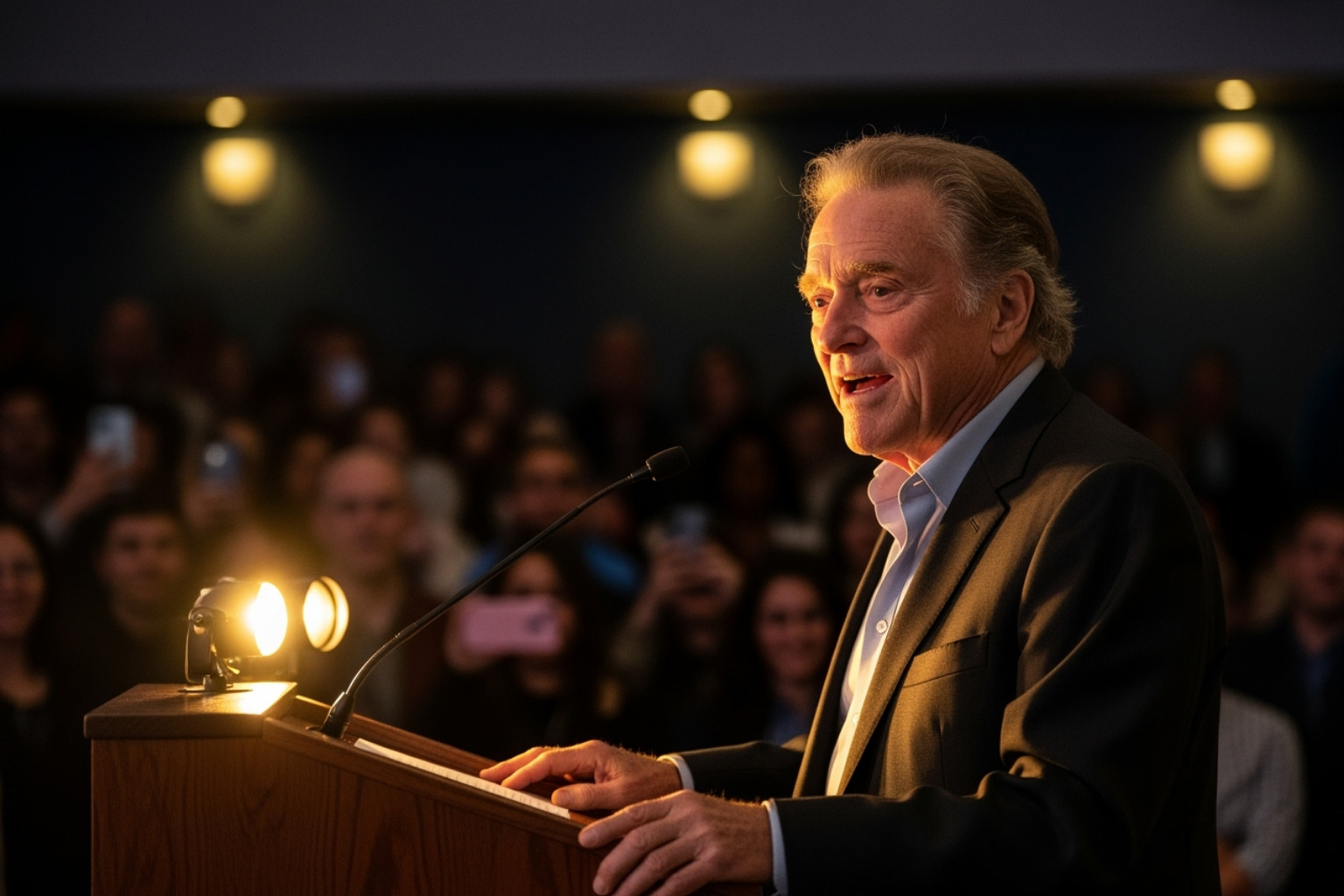
Overcoming Addiction and Health Struggles
The turning point in Richard Dreyfuss’s personal life came in 1982, when his battle with cocaine addiction nearly cost him everything. During a drug-induced blackout, he crashed his car into a tree—an accident he openly admits was entirely his fault. But sometimes our darkest moments can become the catalyst for profound change.
While recovering in the hospital, Richard Dreyfuss experienced what he describes as a “life-altering vision”—an image of a beautiful little girl in a white dress. This powerful moment made him realize the innocent lives he could have harmed and became the turning point that compelled him to save his own life. It’s a testament to how healing can come from the most unexpected places.
His openness about mental health has been equally brave. Richard Dreyfuss has candidly discussed his bipolar disorder diagnosis, including sharing his experiences in a documentary with Stephen Fry. By speaking publicly about these challenges, he’s helped reduce the stigma around mental health issues and encouraged others to seek help.
Even in recent years, health challenges have continued to shape his life. In May 2024, Richard Dreyfuss was hospitalized with viral bronchitis, forcing him to miss SharkCon—an event close to his heart. In typical fashion, he shared a video message with his characteristic humor, saying, “I want you all to feel very sorry for me. And very sorry for yourselves.”
His journey shows us that wellness isn’t a destination—it’s an ongoing process that requires courage, self-awareness, and sometimes a willingness to start over completely. For more insights into how celebrities manage their well-being, check out Inside the Wellness Routines of Your Favorite Celebs.
The Dreyfuss Civics Initiative and Political Views
After conquering his personal demons, Richard Dreyfuss channeled his energy into a cause that would define his later years: civic education. In 2006, he founded The Dreyfuss Civics Initiative (TDCI), which became a formal 501(c)3 organization in 2008. His mission is both simple and profound—to bring civics education back to American schools.
Richard Dreyfuss argues that civics classes have been virtually absent from school curricula since 1970, creating a dangerous gap in how we prepare young people for citizenship. He believes that understanding government and democratic principles isn’t just academic—it’s essential for a functioning society.
As a passionate spokesman for TDCI, he advocates for developing critical thinking skills in young people. He sees politics as a “noble calling” and works to instill this ideal through education rather than partisan rhetoric. His goal is to empower future generations with the knowledge and skills needed for effective leadership and civil discourse.
His political evolution has been equally fascinating. Richard Dreyfuss has stated that he hasn’t been a Democrat since 2004, reflecting a shift in his political thinking. This intellectual journey extends beyond politics into literature—he co-authored the science-fiction novel The Two Georges with Harry Turtledove in 1996, and later wrote One Thought Scares Me… in 2022.
What emerges from his civic work is a picture of someone who refuses to be boxed into easy categories. Richard Dreyfuss has become a thoughtful, if sometimes controversial, public intellectual who believes deeply in the power of education to transform society.
The Enduring and Controversial Career of Richard Dreyfuss
In recent years, Richard Dreyfuss has found himself in the spotlight for reasons that extend far beyond his legendary filmography. While his talent remains undeniable, his outspoken views on contemporary social issues have sparked heated debates and drawn both passionate defenders and vocal critics.
The Personal Battles of Richard Dreyfuss
Richard Dreyfuss has never been one to hold back his opinions, and in recent years, this tendency has led him into some very public controversies. His most vocal criticism has been directed at the Academy’s new diversity guidelines, which he described in particularly harsh terms, saying they “make me vomit.” His reasoning centers on his belief that “movie-making is an art form” and that “no one should dictate morality to artists.”
This stance on artistic freedom extends to his complicated relationship with the MeToo movement. While he has acknowledged being “overly flirtatious” in the past, he firmly denies any allegations of sexual assault. In 2017, writer Jessica Teich accused him of exposing himself to her in the 1980s – an allegation he denied, maintaining that while he may have been “flirtatious,” he did not assault her.
His views have also touched on LGBTQ issues, where he’s been particularly critical of what he calls “wokeness” and has made disparaging comments about parents of transgender children. These positions have placed him at odds with much of Hollywood’s current cultural climate and have drawn significant backlash from various communities.
At the heart of these controversies lies Richard Dreyfuss’s unwavering belief in freedom of speech and his resistance to what he sees as cultural pressures limiting artistic expression. Whether you agree with his positions or not, there’s no denying his commitment to speaking his mind, regardless of the consequences.
The Recent ‘Jaws’ Screening Incident
The most dramatic example of these tensions came to a head in May 2024 at what should have been a celebratory event. Richard Dreyfuss was scheduled to appear at a special screening of Jaws at The Cabot theater in Beverly, Massachusetts – an event that fans expected would be filled with fond memories and behind-the-scenes stories.
Instead, the evening took a sharp turn when Richard Dreyfuss began making controversial remarks that touched on women, the MeToo movement, and LGBTQ youth. His comments, which included disparaging remarks about parents of transgender children, were widely perceived as offensive and completely inappropriate for the venue and audience.
The reaction was immediate and dramatic. Audience walkouts began almost as soon as he started speaking, with many attendees leaving the theater in protest. The atmosphere shifted from anticipation to discomfort, then to outright anger as more people realized the direction his comments were taking.
The theater apology came swiftly. The Cabot issued a statement calling his remarks “unacceptable” and clarifying that his views “do not reflect the values of inclusivity and respect that we uphold.” The incident generated widespread media coverage, with entertainment outlets and news organizations picking up the story and analyzing what it meant for his legacy.
This Beverly screening incident serves as a stark reminder that even beloved figures from our favorite films can hold views that clash dramatically with contemporary values. For many fans, it was a disappointing end to what should have been a nostalgic celebration of one of cinema’s greatest blockbusters.
A Look Back at ‘Jaws’: An Insider’s Perspective
Jaws isn’t just a movie; it’s a piece of history that completely changed Hollywood! It practically invented the idea of a “summer blockbuster.” For Richard Dreyfuss, who played the smart and quirky oceanographer Matt Hooper, it was a huge turning point in his career. While most of us have heard stories about how tough the Jaws filming was, Richard Dreyfuss offers his own wonderfully honest and often funny take on what really went down.
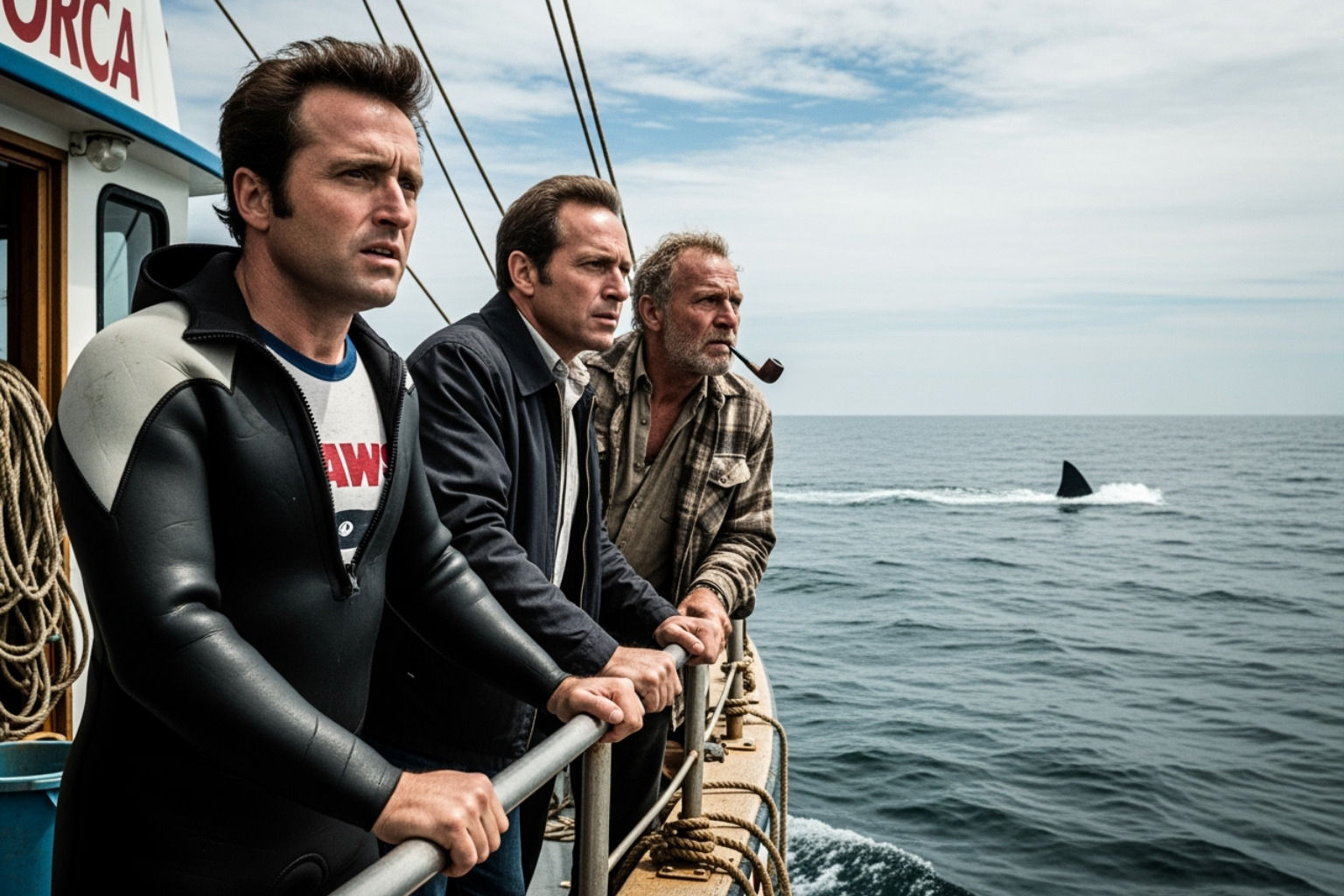
The Truth About the Troubled Shoot
It’s no secret that making Jaws was full of challenges. Director Steven Spielberg was quite young at the time, and they faced all sorts of mechanical shark issues. (They had three of them, actually, and jokingly called them “Bruce”!) Plus, there were unpredictable weather problems and the budget kept growing.
But here’s a fresh take from Richard Dreyfuss. He actually thought Jaws would be a “total disaster” back then. He even went on a TV show and publicly said it would flop! He later chuckled about this, calling himself “the stupidest actor in America” once he saw how amazing the finished movie was.
His biggest complaint during the Jaws filming wasn’t the broken mechanical sharks or other technical headaches. Nope, it was pure, simple boredom! Imagine waiting for hours and hours for the perfect shot. He famously recalled waiting for sailboats to move out of the background, which could take a painful “about an hour and a half” each time. So, for Richard Dreyfuss, the real test of patience on set was the endless waiting. It’s ironic that Spielberg’s brilliant choice to keep the shark mostly off-screen, building incredible suspense, was actually born out of those very mechanical failures. A problem turned into genius!
The Iconic U.S.S. Indianapolis Speech
Even with all the challenges and his early doubts, Richard Dreyfuss truly respects Jaws as a work of art. If you ask him about his favorite part of the film, he always points to the powerful and haunting U.S.S. Indianapolis speech. This incredible scene is delivered by his co-star, Robert Shaw, who played the grizzled shark hunter, Quint. The monologue tells the chilling true story of a shark attack after a WWII ship sinking. It’s a masterclass in storytelling and building tension!
You might have heard whispers of a “feud” between Richard Dreyfuss and Robert Shaw during filming. Well, Richard Dreyfuss firmly denies any such animosity. He insists that any supposed rivalry was mostly made up or blown out of proportion. He’s even expressed his dislike for the play The Shark Is Broken, which dramatizes the behind-the-scenes struggles of Jaws, saying it wrongly creates a “feud that never happened.” It just goes to show that what we hear about movie sets isn’t always the full story! We invite you to revisit this classic moment and experience the intensity of The Robert Shaw speech about the U.S.S. Indianapolis.
Frequently Asked Questions about Richard Dreyfuss
We know many of you are curious about this legendary actor’s life and career, so let’s dive into the most common questions people ask about Richard Dreyfuss.
How old is Richard Dreyfuss?
Richard Dreyfuss was born on October 29, 1947, making him 77 years old as of 2024. It’s remarkable to think he’s been captivating audiences for over six decades now, having made his debut in the mid-1960s when he was just a teenager.
His longevity in Hollywood is truly impressive. From his early days as a young actor struggling to make his mark to becoming one of the most recognizable faces of the New Hollywood era, he’s witnessed and participated in the industry’s evolution firsthand.
What is Richard Dreyfuss best known for?
When people think of Richard Dreyfuss, three iconic roles immediately come to mind. First, there’s his unforgettable portrayal of Matt Hooper, the enthusiastic oceanographer in Steven Spielberg’s groundbreaking thriller Jaws (1975). This role helped launch the summer blockbuster phenomenon we know today.
Then came his mesmerizing performance as Roy Neary in Close Encounters of the Third Kind (1977), where he played an ordinary man whose life is turned upside down by an extraordinary encounter. This collaboration with Spielberg further cemented his status as a leading man of his generation.
But perhaps his most celebrated achievement is his Academy Award-winning performance as Elliot Garfield in The Goodbye Girl (1977). This romantic comedy showcased his incredible range, blending humor with genuine emotion. At just 30 years old, he became the youngest Best Actor Oscar winner at the time – a record that stood for 25 years.
Later in his career, his moving portrayal of music teacher Glenn Holland in Mr. Holland’s Opus (1995) reminded audiences of his dramatic depth and earned him another Oscar nomination. This role resonated deeply with viewers, showing how one teacher’s passion can transform countless lives.
What is The Dreyfuss Civics Initiative?
The Dreyfuss Civics Initiative (TDCI) represents Richard Dreyfuss’s passionate commitment to education and democracy. He founded this non-profit organization in 2006, officially establishing it as a 501(c)3 in 2008.
The initiative’s mission is both simple and profound: to bring civics education back to American public schools. Dreyfuss noticed that comprehensive civics classes had largely disappeared from school curricula since around 1970, creating what he saw as a dangerous gap in young people’s education.
Through TDCI, he advocates for teaching students about their rights and responsibilities as citizens, the principles of democratic government, and the importance of civil discourse. He believes that understanding how our government works and developing critical thinking skills are essential for maintaining a healthy democracy.
His vision goes beyond just textbook learning. Richard Dreyfuss wants to inspire young people to see politics as a “noble calling” and to become engaged, informed citizens who can contribute meaningfully to society. It’s a cause he speaks about with the same passion he once brought to his most memorable film roles.
A Complex Legacy of Art and Opinion
When we look at the extraordinary journey of Richard Dreyfuss, we can’t help but feel moved by the sheer complexity of his story. Here’s a man who helped shape modern cinema, creating unforgettable moments that still give us chills decades later. From that first glimpse of the shark in Jaws to the emotional crescendo of Mr. Holland’s Opus, his performances have become part of our collective memory.
His artistic achievements speak for themselves. Richard Dreyfuss didn’t just act in movies—he helped create the very concept of the summer blockbuster. His collaborations with Steven Spielberg changed how we experience films, turning movie theaters into places where entire families could share wonder and excitement together.
But what makes his story even more compelling is his incredible personal resilience. When we think about his battle with cocaine addiction and his openness about bipolar disorder, we see someone who refused to let his struggles define him. That life-changing moment in 1982—when he crashed his car and had that vision of a little girl in a white dress—became his turning point. It’s a powerful reminder that sometimes our darkest moments can lead to our greatest changes.
This kind of personal growth and commitment to wellness resonates deeply with everything we believe in at Beyond Beauty Lab. True beauty and wellness come from facing our challenges head-on and choosing to heal, just as Richard Dreyfuss did.
However, we can’t ignore the more controversial aspects of his recent public life. His strong criticisms of Hollywood’s diversity guidelines, his comments about the #MeToo movement, and his remarks about LGBTQ+ issues have created significant backlash. The May 2024 incident at the Jaws screening in Beverly, Massachusetts, where audience members walked out after his comments, shows how his views can clash with contemporary values.
His founding of The Dreyfuss Civics Initiative reveals another layer of his personality—a man genuinely concerned about civic education and democracy. Yet even this noble effort gets overshadowed by his more polarizing statements.
Richard Dreyfuss remains one of Hollywood’s most fascinating figures precisely because he refuses to be easily categorized. He’s a brilliant actor whose films brought joy to millions, a survivor who overcame serious personal demons, and a passionate advocate whose strong opinions continue to spark heated debates.
His legacy reminds us that people are wonderfully complicated. We can appreciate his artistic genius while acknowledging that his recent public statements have been problematic for many. That’s what makes him so uniquely human—and so endlessly interesting to discuss.
As we continue exploring the complex lives of public figures and their wellness journeys, we invite you to explore more celebrity stories and wellness insights with us at Beyond Beauty Lab.

